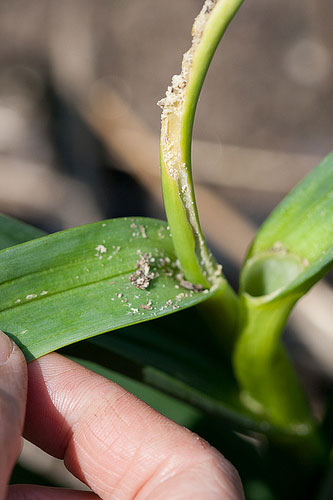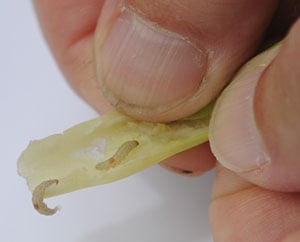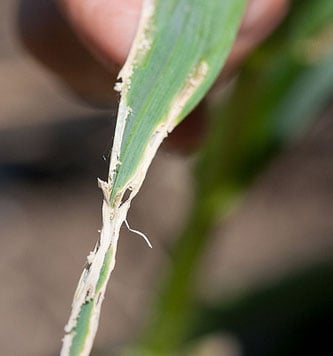Here Comes the Leek Moth
Sadly, we found evidence of the leek moth (Acrolepiopsis assectella) in our garlic beds last week. The worst part about this is that the garlic was doing beautifully — it was the shining star of the garden and was earmarked for a food shelf donation.

The leek moth is a fairly new pest that you may not be familiar with, as it is just beginning to appear in the U.S., isolated to just a few states. Originating in Europe, it somehow made its way to northeastern Canada several years back and has been spreading southward ever since. The moth appeared more widely in Vermont last year, a fact I am deeply familiar with as I found it in my own garden last June. Leek moth favors plants in the allium family, especially onions, leeks, garlic, shallots and chives.
The adult moth is brown and white and is nocturnal, making it difficult to identify. The adults lay eggs on the host plant, and then, a week or so later, small, yellow larvae hatch and begin feeding. The first generation of larvae eats the leaves. Generations that emerge later in the summer find their way inside the plant, working their way down into the bulb. The invasion usually causes the bulb to rot, either in the ground or after being harvested and stored.
 After the larvae finish feeding, they emerge from the plant and spin a mesh net around themselves and enter the pupae stage. At this stage, they are attached to the outer leaves and easy to see.
After the larvae finish feeding, they emerge from the plant and spin a mesh net around themselves and enter the pupae stage. At this stage, they are attached to the outer leaves and easy to see.
If you see the pupae, squish them. This is also a good time to remove infested plants in an effort to stop the life cycle. Removal may also help to prevent the pest from overwintering in your soil because, after adult moths emerge late in the season, they hibernate for the winter and emerge again in the spring to mate and lay eggs to start the cycle again.
As soon as you see the damage, start these leek moth control strategies:
 The biological control in our Caterpillar Control, Bacillus thuringiensis (Bt), is effective in the larval stage. This organic pesticide is made from naturally occurring bacteria that affect only the caterpillar stage (larvae) of moths and butterflies that ingest it. It causes them to stop eating and kills them within a few days.
The biological control in our Caterpillar Control, Bacillus thuringiensis (Bt), is effective in the larval stage. This organic pesticide is made from naturally occurring bacteria that affect only the caterpillar stage (larvae) of moths and butterflies that ingest it. It causes them to stop eating and kills them within a few days.
 Remove and destroy damaged foliage early in the season. Look for the larvae and damage on the leaves.
Remove and destroy damaged foliage early in the season. Look for the larvae and damage on the leaves.- Later generations burrow into the plant making it more difficult to see, unless you cut the plant open to reveal its whereabouts. Remove the plants from the garden.
- Remove plant debris from the garden at the end of the season to decrease the number of adults that overwinter.
- Plant leeks, onions and other alliums a few weeks later in the season to avoid the first generation of adults and eggs.
Learn more about leek moth from Cornell University.
Print this Article:
Get the Dirt
Stay up to date on new articles and advice. Please fill out the information below.

